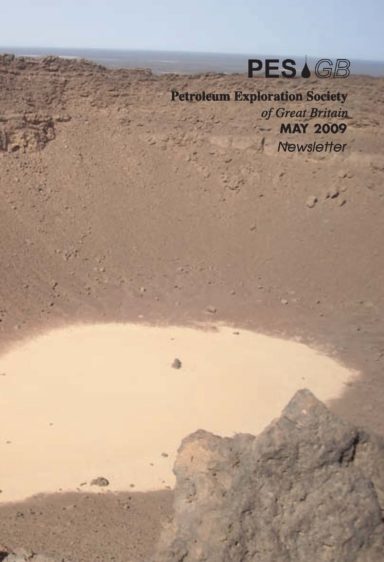PESGB May 2009
- Mexico
- Past President Reminiscences
Plus much more inside
President’s Page- Jon Gluyas
This month’s London lecture from the PESGB is by Chris Clayton on biogenic gas. While reading the abstract that Chris prepared for our lecture, I thought about how much our understanding has changed in the past 30 years and how the technology we now take for granted simply did not exist when I began to work in the petroleum industry. For example, I recall an undergraduate course I took at Sheffield in 1977, on the origin of petroleum; it was run out of the chemistry department. We received several lectures on the assay analysis of petroleum retorted from Green River Shale in Wyoming and were reminded of James “Paraffin” Young and his work with the Lothian Oil Shales. Other than the effects of heat and time, how oil actually formed was a mystery and was admitted to be so by the lecturer. Today we can sample oils, source rocks and even tiny fluid inclusions trapped by growing minerals and make precise statements about the degree of maturity of the oil from the various organic compounds. We can also type oils to source rocks, and we can predict areas and fluids likely to contain nonhydrocarbon gasses such as nitrogen, CO2 and H2S.
The great steps forward in geochemistry in the last three decades have been matched in many of the disciplines which go to make up petroleum exploration, appraisal and production. When we consider the quality of seismic data, much has changed too. We now expect to be able to see inside many of the reservoirs we are exploiting and for some we can witness temporal changes associated with petroleum production. Not so 30 years ago: major field developments had to be sanctioned on a handful of wells and a seismic dataset that rarely got beyond delivering a fuzzy view of the trap envelope.
The change in our understanding and the technology used by geoscientists coupled with that from our colleagues in reservoir engineering and drilling means that nowadays we routinely deliver around 50% of the oil in place from a field. This compares with around 35% which was the norm when I began work in 1981. Depending on how we choose to do the arithmetic, we can either say that the improvement has been by nearly ½% increments for each of those 28 years, or we can say that a 15% increase from a 35% base represents a 28% improvement, which averages to 1% for each of the 28 years; isn’t it wonderful what we can achieve with mathematics! More interestingly, if we were to extrapolate, what recovery factors might we expect to achieve with another 30 years of technological advances? One way you might start to get an answer to that question is to attend DEVEX in Aberdeen later this month. With a full programme of talks (www.devex.conference.org) I would hope there to be inspiration for many of us. A different way to extrapolate over a long timescale is to look at the people being asked to achieve the next round of improvements, which is what I was doing when judging this year’s Barrel Awards at Imperial College in late March. There were 55 students from 14 different countries working in 11 teams (“oil companies”). We were treated to expositions on the exploration potential of various basins and blocks around the world. The quality of the presentations was high and I was moved to think what might these young geoscientists deliver to our industry as they mature in their degree and then their careers; how much better will they be at finding and producing a dwindling resource? I wish them the very best in what will become an increasingly difficult pursuit.


